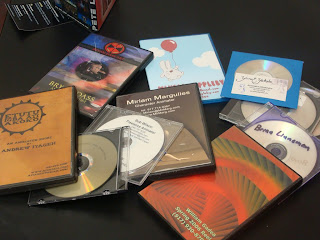The demo DVD is one part of your "marketing identity" as an artist. It should be a complement to a website and a portfolio.
Ten years ago, sample reels were a delicate thing.
That's when they went out on tape. 3/4 inch UMatic for studios and long time professionals, VHS for (in today's lingo) n00bs. I can only imagine the nightmare and expense of 16mm reels from earlier generations.
Today's sample reel is a DVD. Previous formats were linear. The demo had one or two minutes to convince the producer to watch the next three or four minutes. While it's still important to front load your reel with the best work, that's less crucial than it once was.
Let's start with the externals, the packaging. Sandpaper packaging, star shaped glittery boxes, candy covers, oversized or undersized containers all can make for a striking presentation -and we are in a visual, creative field. While I always appreciate the effort and eye behind an unusual design -these are always the first things to get tossed in trash during a cleaning binge. They stick out and can't be stored with the rest of the samples. Larger companies may have the space to store shelves upon shelves of unsolicited work, but real estate is premium in a studio and if it's not being used it'll get cast aside.
Take the standard DVD package as a constraint and design into it. Evident on the package should be your name and contact information (both telephone and email). Include what you "are": animator, flash artist, Maya generalist, etc. Also include a return address -sometimes we'll return them although usually we won't. After that, it's an open for design. I prefer when the packaging gives an inkling of what the contents will be.
Also, CD jewelboxes will be reused when the studio runs out of boxes. Your DVD will then be homeless, until tossed into the trash.
I also like when the artist sees their reel/website/portfolio as a package and designs them all with a theme. Sure, most of the time won't see this. Think of how a unified presentation makes you think of your own work.
Still on the outside: a table of contents. What's on the reel. It can be complicated, as long as it starts simple. List what's on there. Make the design work with the rest of the package, don't just type it on 8 1/2 x 11 and fold in there.
Now for the contents.
If you are Technical Director, do not include work that you did the rigging for. If you only did the rigging, be forthright and acknowledge the animators and TD. People neglect to this sort of thing regularly. For the most part, I think its honest oversight -having what you did clearly spelled out gives the producer a better way to evaluate your abilities.
The common way to advancement in this field is the "bump up". An assistant will be given a shot to animate, an animator a chance to direct. The "bump up" does not happen on your sample reel. If you modeled and rigged a character don't claim you can be the TD. The producer will make that decision based on the work.
In the DVD world, you have the opportunity to tailor the presentation of your work that the VHS reel didn't offer. Few people take advantage of this.
Take a cue from commercial DVDs. They have an intro, a main menu, a feature presentation, sub menus with extras. The artist's demo can have all of these.
I'd suggest making the intro short. Ten to fifteen seconds is plenty.
A main menu which contains at the very least your "short reel", contact information, and if you have them -full length versions of your work. Other contents can include illustration montages (not a good idea), work process like pencil tests, animatics or shot breakdowns or biographic information.
Full length works should be accessed through a sub menu and be screenable as a "play all" or individually. You want a menu which lets you direct someone by simply saying "Look at this Volkswagon spot if you want to see some liquid I animated".
The most important part of the DVD is the "short reel". Again, in the old days this was a different matter. It would typically consist of three to five minutes worth of full pieces or substantial excerpts. With the DVD it can be a shorter run through many clips from your work. It's a highlight reel which leads the producer to screen work from the full length menu.
The construction of the "short reel" is fairly straightforward. Find all of your best pieces, put the best of the best up front and edit them to a track which gives insight into you as an artist.
It's acceptable to show only your part of the process -a pencil test or leica reel for an animator, the bones of a model for a rigger. If you do that, it's also recommended that you reveal the final version at some point to see how your work contributes to the process.


2 comments:
Great advice and a nice companion to your piece on Web sites. I would add that an animator shouldn't have one reel that they send out to everyone for every opportunity. It's so easy to make a specialty reel these days. If one is going for a preschool animation gig than make a reel tailored to that, one that would not include work done for Adult Swim, for instance.
Definitely have tailored reels.
It's simple to have DVD authoring projects with all the same packaging but replacing the featured reel.
I wrote this with younger artists in mind who may not have a variety of work. In that case, just stick with your best stuff.
Post a Comment